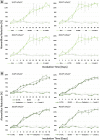Seaweed cellulose scaffolds derived from green macroalgae for tissue engineering
- PMID: 34088909
- PMCID: PMC8178384
- DOI: 10.1038/s41598-021-90903-2
Seaweed cellulose scaffolds derived from green macroalgae for tissue engineering
Abstract
Extracellular matrix (ECM) provides structural support for cell growth, attachments and proliferation, which greatly impact cell fate. Marine macroalgae species Ulva sp. and Cladophora sp. were selected for their structural variations, porous and fibrous respectively, and evaluated as alternative ECM candidates. Decellularization-recellularization approach was used to fabricate seaweed cellulose-based scaffolds for in-vitro mammalian cell growth. Both scaffolds were confirmed nontoxic to fibroblasts, indicated by high viability for up to 40 days in culture. Each seaweed cellulose structure demonstrated distinct impact on cell behavior and proliferation rates. The Cladophora sp. scaffold promoted elongated cells spreading along its fibers' axis, and a gradual linear cell growth, while the Ulva sp. porous surface, facilitated rapid cell growth in all directions, reaching saturation at week 3. As such, seaweed-cellulose is an environmentally, biocompatible novel biomaterial, with structural variations that hold a great potential for diverse biomedical applications, while promoting aquaculture and ecological agenda.
Conflict of interest statement
The authors declare no competing interests.
Figures








Similar articles
-
Decellularized Green and Brown Macroalgae as Cellulose Matrices for Tissue Engineering.J Funct Biomater. 2024 Dec 23;15(12):390. doi: 10.3390/jfb15120390. J Funct Biomater. 2024. PMID: 39728190 Free PMC article.
-
Decellularized natural 3D cellulose scaffold derived from Borassus flabellifer (Linn.) as extracellular matrix for tissue engineering applications.Carbohydr Polym. 2021 Nov 15;272:118494. doi: 10.1016/j.carbpol.2021.118494. Epub 2021 Jul 29. Carbohydr Polym. 2021. PMID: 34420749
-
Fabrication of bimodal open-porous poly (butylene succinate)/cellulose nanocrystals composite scaffolds for tissue engineering application.Int J Biol Macromol. 2020 Mar 15;147:1164-1173. doi: 10.1016/j.ijbiomac.2019.10.085. Epub 2019 Nov 18. Int J Biol Macromol. 2020. PMID: 31751685
-
The Emerging Role of Decellularized Plant-Based Scaffolds as a New Biomaterial.Int J Mol Sci. 2021 Nov 16;22(22):12347. doi: 10.3390/ijms222212347. Int J Mol Sci. 2021. PMID: 34830229 Free PMC article. Review.
-
From model organism to application: Bacteria-induced growth and development of the green seaweed Ulva and the potential of microbe leveraging in algal aquaculture.Semin Cell Dev Biol. 2023 Jan 30;134:69-78. doi: 10.1016/j.semcdb.2022.04.007. Epub 2022 Apr 19. Semin Cell Dev Biol. 2023. PMID: 35459546 Review.
Cited by
-
Understanding Macroalgae: A Comprehensive Exploration of Nutraceutical, Pharmaceutical, and Omics Dimensions.Plants (Basel). 2023 Dec 31;13(1):113. doi: 10.3390/plants13010113. Plants (Basel). 2023. PMID: 38202421 Free PMC article. Review.
-
Cultivation of bovine lipid chunks on Aloe vera scaffolds.NPJ Sci Food. 2025 Feb 25;9(1):26. doi: 10.1038/s41538-025-00391-1. NPJ Sci Food. 2025. PMID: 40000634 Free PMC article.
-
The potent osteo-inductive capacity of bioinspired brown seaweed-derived carbohydrate nanofibrous three-dimensional scaffolds.Mar Life Sci Technol. 2024 Jul 24;6(3):515-534. doi: 10.1007/s42995-024-00241-1. eCollection 2024 Aug. Mar Life Sci Technol. 2024. PMID: 39219680 Free PMC article.
-
Electrospun Nanomaterials Based on Cellulose and Its Derivatives for Cell Cultures: Recent Developments and Challenges.Polymers (Basel). 2023 Feb 26;15(5):1174. doi: 10.3390/polym15051174. Polymers (Basel). 2023. PMID: 36904415 Free PMC article. Review.
-
Biomimetic Three-Dimensional (3D) Scaffolds from Sustainable Biomaterials: Innovative Green Medicine Approach to Bone Regeneration.J Funct Biomater. 2025 Jun 29;16(7):238. doi: 10.3390/jfb16070238. J Funct Biomater. 2025. PMID: 40710453 Free PMC article. Review.
References
-
- Ratner, B. D., Hoffman, A. S., Schoen, F. J. & Lemons, J. E. Biomaterials Science: An Introduction to Materials in Medicine (Elsevier, 2013).
-
- Lanza, R., Langer, R. & Vacanti, J. Principles of Tissue Engineering (Academic Press, 2020).
Publication types
MeSH terms
Substances
LinkOut - more resources
Full Text Sources
Other Literature Sources
Research Materials

